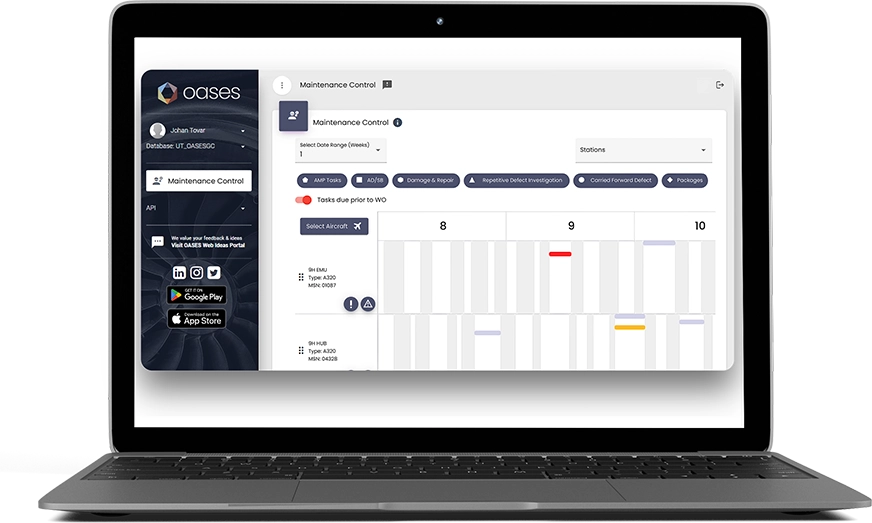Post Pandemic: How CAMOs and airlines can prepare for the next round of challenges
by Saidhar Pathigari, VP New Business at Commsoft OASES

The short lifespan of the ‘new norm’
For Continuing Airworthiness Management Organisations (CAMOs) and airline start-ups, the pressure mounts at just a time when it may have been seen to be lessening. For some, adjustments made to operations, in response to pandemic pressures, may well have created the foundations for what comes next.
The world rapidly adjusted to new behaviours following the ravages of COVID. There were sighs of relief in businesses, but just when it appeared things may be restoring to normal— albeit a ‘new normal’—other factors dictate a new assessment of quite what that new normal might look like.
The Russian invasion of Ukraine sends impacts across global economies, oil prices have risen to over $110 per barrel, and many countries are experiencing unprecedented rises in the cost of living. Citigroup analysts have said: “…we see the aggregate probability of recession as now approaching 50%.”
The digital approach to airline operations agility
Among the adjustments that CAMOs and start-ups responded to, both during and in the wake of the pandemic, was the shift to remote working where possible. This requirement triggered the adoption of cloud technologies to facilitate ‘anywhere’ access to critical data in real-time, greater visibility of systems and maintenance processes/schedules, and the accelerating move to digitisation.
While some have moved rapidly along this path, others are yet to explore the benefits to be gained. In many of the conversations I have with OASES customers—and those considering the adoption of paperless processes and digital efficiencies—two common threads emerge: The need to reduce operational costs wherever safely feasible, regulatorily compliant, and strategically beneficial; combined with the more pressing need to become more agile. The time-honoured phrase of the technology world is also much mentioned – how to do more with less?
Just little over a year ago, the outlook for the airline sector was optimistic, yet slightly diluted with a pinch of pessimism. McKinsey & Company observed: “Business travel…will only likely recover to around 80% of pre-pandemic levels by 2024…While leisure passengers fill up most of the seats on flights and help cover a portion of fixed costs, their overall financial contributions in net marginal terms are negligible, if not negative”.
Technology has a significant role to play in enabling small operators to contend with problems yet to come. Improving turnaround times, enhancing the efficiency of maintenance schedules, and streamlining the MRO workflow across and between teams are all about adhering to best practice.
In a digital world, ‘best practice’ leaves no room for misinterpretation of instructions or schedules, no margin for human error, and no equivocation about scheduled tasks,
or balancing them with the needs for immediate actions. This is a paperless world.
What customers expect
It’s an agile world, and this is the best possible place to be when preparing for the challenges to come. It should not be overlooked that the challenges of the global economy, and changing customer behaviours, are intensified by the competitive environment.
It’s an environment populated by other operators running on leaner cost structures, offering both freight and leisure customers a better experience deriving from operations that are more efficient, and more in line with the speed of turnaround all customers expect.
The three pillars of risk mitigation and effectiveness optimisation
Commsoft is guiding many start-ups and CAMOs—at this point in time, particularly in Eastern Europe, Africa, and the Middle East—to automate manual workloads as a route to ensuring robust regulatory compliance.
While compliance is the number one priority in the aviation industry, it is far from being the only one. Compliance is both a responsibility and a guideline; making it clear how airlines must address maintenance and safety. Post-pandemic, the search for appropriately skilled workers has become harder. This places the onus on organisations to enable their current teams to work smarter; using their skills to the fullest, and removing from their daily tasks the complexity of reporting and form-filling. These are processes that can now easily be automated through the deployment of MRO software.
Across the operational environment, a smarter approach is required; making strategic and operational decisions about how your business will meet regulatory requirements with confidence, both in structured and data-driven workflows and in the ability to provide demonstrable evidence of best practice—the audit trail. Smart, data-driven, and best practice are the three essential foundations of risk mitigation and effectiveness optimisation.
- What does ‘smarter’ mean?
In its basic form, ‘smarter’ is about the elimination of paper processes. Many customers I talk to are still reliant on spreadsheets, manually generated reports, and the communication of instructions and actions via email. The two key weaknesses of such approaches are:
– They permit human error; manual processes do not allow any degree of automated checking
– They compound complexity and workload; audits become labour-intensive, time-consuming, and costly. Paper-based processes are also an insecure basis for inter- and intra-team communications.
Ensuring that the right records are kept in the right place becomes an issue. Scouring through emails to locate the most up-to-date information is not a reliable approach. Somewhere in that melee of record keeping, safety issues may not have been correctly addressed. All this adds up to risk. It’s risk that can easily be removed from the business through Aviation MRO sotware. Smarter, in its more advanced form, means going digital with these processes and workflows. It means, essentially, enjoying the confidence and ease of administration that all the paper in the world cannot ever match.
- What does data-driven mean?
Every action creates data; from those undertaken by engineers and logistics operatives, and those involved in works order and material pre-load planning, line maintenance and control, material management, all the way through to customs tracking, and commercial and warranty management. The efficient organisation connects this data to learn from it, exploit it, and leverage it for continuous operational improvement.
Being data-driven is about understanding the criticality of data; tempered with an understanding that the biggest and most complex organisations in aviation are truly advanced along this route-—the journey to digital transformation.
- What does best practice look like?
When everyone on your team has a complete and easy-to-access view of how their actions impact through the rest of the team—accessing a ‘single view of the truth’ with aviation maintence software—everything runs more smoothly. When your organisation can easily interact with your supply chain, and gain visibility of status at any time, nothing is left to chance.
Best practice is about sharing that single view of the truth; a view which is always changing in real-time to reflect precisely what is happening where, and what will be happening next. The single view of the truth is only possible by being data-driven, and that depends on being smarter.
Commsoft’s Open Aviation Strategic Engineering System (OASES) provides a set of software modules that drive end-to-end, compliance-focused, digitised MRO workflows. Data is at its core, and it’s actually easier to use than paper-based systems. Data entered once is available for any functionality (the single view of the truth) among the system’s nine modules, which cover the gamut of your operations. I invite you to take a look OASES Modules, but here is a flavour of the complete suite:
Prepare for the next challenge
If you want to find out more about going completely paperless to minimise risk (and stress), streamline your operations, and sharpen your competitive advantage, just email me at: [email protected]
World Economic Forum: How does the war in Ukraine affect oil prices?
Reuters June 23 2022: Chances of global recession nearing 50% – Citigroup
McKinsey&Company: Back to the future? Airline sector posed for change post-COVID-19
To learn more or book an OASES demo, contact us today
For organisations looking to ascend to new heights of operational excellence, contact us today to book a demo.


